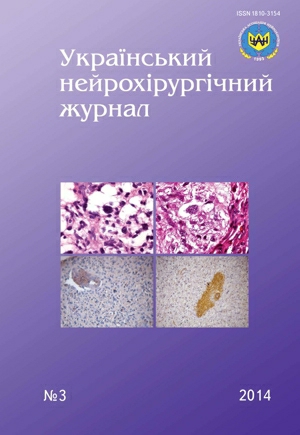MR-tractography method: modern features of visualization and use in neurosurgical practice
DOI:
https://doi.org/10.25305/unj.47498Keywords:
gliomas, schwannomas, meningiomas, metastases, cavernous angiomas, MR-tractography, conductive pathsAbstract
Introduction. Modern features of MR-tractography in neuroimaging and at neurosurgical intervention planning at different brain tumors are presented.
The purpose. To study MR-tractography facilities for use in neurosurgical practice by assessing the state of pathways at different brain tumors and their impact on the trajectory of main pathways.
Materials and methods. MRI with MR-tractography were performed 143 patients with different brain tumors, 82 of them have been operated with further histological verification.
Results. According to MR-tractography data gliomas were characterized by infiltration, destruction of conductive fibers and main pathways in the area of tumor growth, paths offset due to tumor’s volume effect. Nodal tumors (schwannoma, meningioma, solitary metastasis, cystic formation, cavernous angioma) were characterized by offset of conductive fibers and the main paths, without tampering. In case of tumor’s significant volume impact on brain tissue paths thinning was observed due to compression of their fibers. Surgical tactics at volume formations, particularly at gliomas, was determined by degree of main paths lesion.
Conclusions. MR-tractography — an advanced method to assess conductive paths lesion degree at brain tumors, it’s data are used in modern neurosurgery.
References
Lee SK, Kim DI, Kim J, Kim DJ, Kim HD, Kim DS, Mori S. Diffusion-tensor MR imaging and fiber tractography: a new method of describing aberrant fiber connections in developmental CNS anomalies. Radiographics. 2005;25:53-65. [PubMed]
Salnikova OS, Ruditsa VI, Robak KO. Vykorystannya dyfuziyno-tenzornykh zobrazhenʹ v nevrolohichniy praktytsi (ohlyad literatury) [The use of diffusion tensor images in neurological practice (literature review)]. Promeneva diahnostyka, promeneva terapiya. 2007;2:35-39.Ukrainian.
Sanai N, Berger MS. Extent of resection influences outcomes for patients with gliomas. Rev. Neurol. 2011;167(10):648-654. [CrossRef] [PubMed]
Chen Y, Shi Y, Song Z. Differences in the architecture of low-grade and high-grade gliomas evaluated using fiber density index and fractional anisotropy. J. Clin. Neurosci. 2010;17(7):824-829. [CrossRef] [PubMed]
Rozumenko VD, Chuvashova OYu, Ruditsa VI, Rozumenko AV. [MR-tractography in image-guide surgery of brain tumors]. Ukrainian Neurosurgical Journal. 2011;(2):65-69. Russian.
Castellano A, Bello L, Michelozzi C, Gallucci M, Fava E, Iadanza A, Riva M, Casaceli G, Falini A. Role of diffusion tensor magnetic resonance tractography in predicting the extent of resection in glioma surgery. J. Life Sci. Med. Neuro-Oncol. 2011;14(2):192-202. [CrossRef] [PubMed]
Christoforidis GA, Yang M, Abduljalil A, Chaudhury AR, Newton HB, Epstein CR, Yuh WT, Watson S, Robitaille PM. Tumoral pseudoblush identified within gliomas at high-spatial-resolution ultrahigh-field-strength gradient-echo MR imaging corresponds to microvascularity at stereotactic biopsy. Radiology. 2012;264(1):210-217. [CrossRef] [PubMed]
Duffau H. New concepts in surgery of WHO grade II gliomas: Functional brain mapping, connectionism and plasticity — a review. J. Neurooncol. 2006;79(1):77-115. [PubMed]
Bozzali M, MacPherson SE, Cercignani M, Crum WR, Shallice T, Rees JH. White matter integrity assessed by diffusion tensor tractography in a patient with a large tumor mass but minimal clinical and neuropsychological deficits. Funct. Neurol. 2012;27(4):239-246. [PubMed]
Gerganov VM, Giordano M, Samii M, Samii A. Diffusion tensor imaging-based fiber tracking for prediction of the position of the facial nerve in relation to large vestibular schwannomas. J. Neurosurg. 2011;115(6):1087-1093. [CrossRef] [PubMed]
Taoka T, Hirabayashi H, Nakagawa H, Sakamoto M, Myochin K, Hirohashi S, Iwasaki S, Sakaki T, Kichikawa K. Displacement of the facial nerve course by vestibular schwannoma: Preoperative visualization using diffusion tensor tractography. J. Magn. Reson. Imag. 2006;24(5):1005-1010. [PubMed]
Grigoryan YuA. Trigeminal'naya nevralgiya i opukholi mostomozzhechkovogo ugla [Trigeminal neuralgia and cerebellopontine angle tumors]. Ros Neyrokhirurg Zhurn Im Prof AL Polenova. 2010;2(1):28-41. Russian.
Carvi Y, Nievas MN, Hoellerhage HG, Drahten C. White matter tract alterations assessed with diffusion tensor imaging and tractography in patients with solid posterior fossa tumors. Neurol. Ind. 2010;58(6):914-921. [CrossRef] [PubMed]
Chen DQ, Quan J, Guha A, Tymianski M, Mikulis D, Hodaie M. Three-dimensional in vivo modeling of vestibular schwannomas and surrounding cranial nerves with diffusion imaging tractography. Neurosurgery. 2011;68(4):1077-1083. [CrossRef] [PubMed]
Hodaie M, Quan J, Chen DQ. Hodaie M. In vivo visualization of cranial nerve pathways in humans using diffusion-based tractography. Neurosurgery. 2010;66(4):788-796. [CrossRef] [PubMed]
Lui YW, Law M, Chacko-Mathew J, Babb JS, Tuvia K, Allen JC, Zagzag D, Johnson G. Brainstem corticospinal tract diffusion tensor imaging in patients with primary posterior fossa neoplasms stratified by tumor type: a study of association with motor weakness and outcome. Neurosurgery. 2007;61(6):1199-1207. [PubMed]
Downloads
Published
How to Cite
Issue
Section
License
Copyright (c) 2014 Kristiana Robаk, Olga Chuvashova

This work is licensed under a Creative Commons Attribution 4.0 International License.
Ukrainian Neurosurgical Journal abides by the CREATIVE COMMONS copyright rights and permissions for open access journals.
Authors, who are published in this Journal, agree to the following conditions:
1. The authors reserve the right to authorship of the work and pass the first publication right of this work to the Journal under the terms of Creative Commons Attribution License, which allows others to freely distribute the published research with the obligatory reference to the authors of the original work and the first publication of the work in this Journal.
2. The authors have the right to conclude separate supplement agreements that relate to non-exclusive work distribution in the form of which it has been published by the Journal (for example, to upload the work to the online storage of the Journal or publish it as part of a monograph), provided that the reference to the first publication of the work in this Journal is included.









